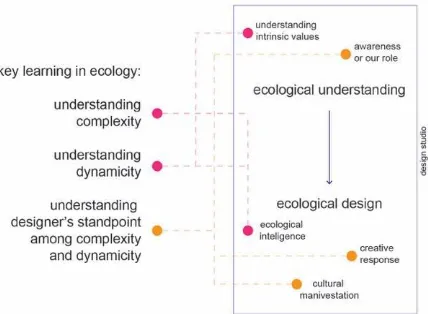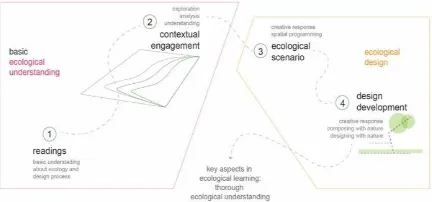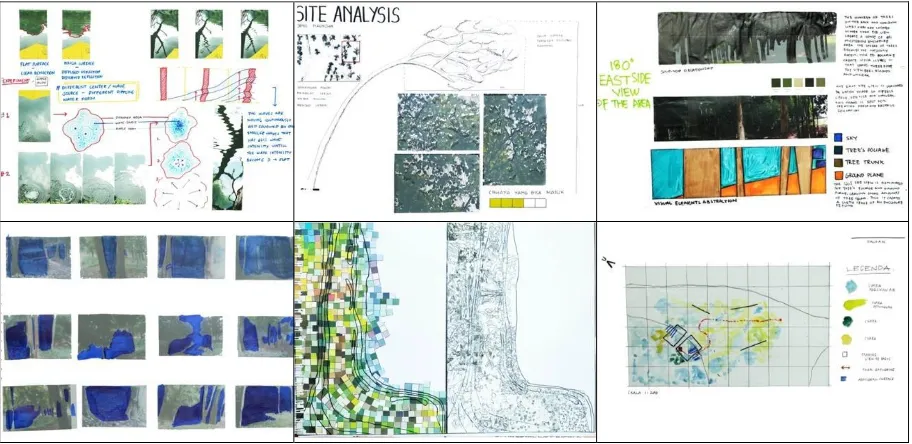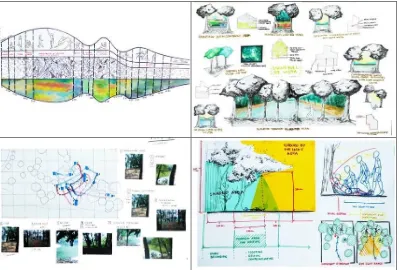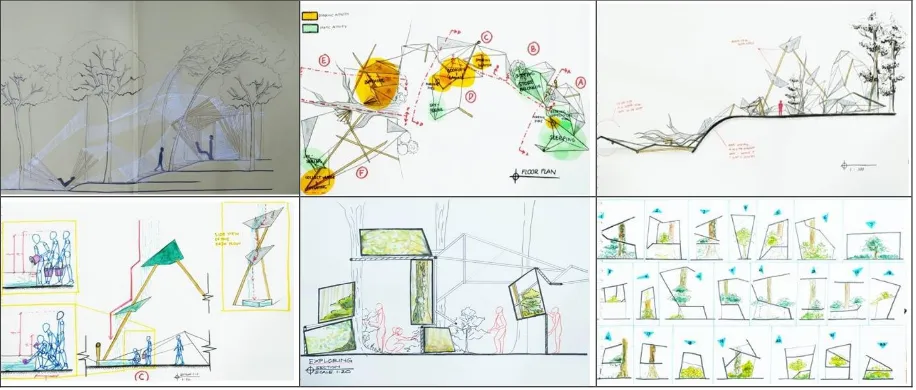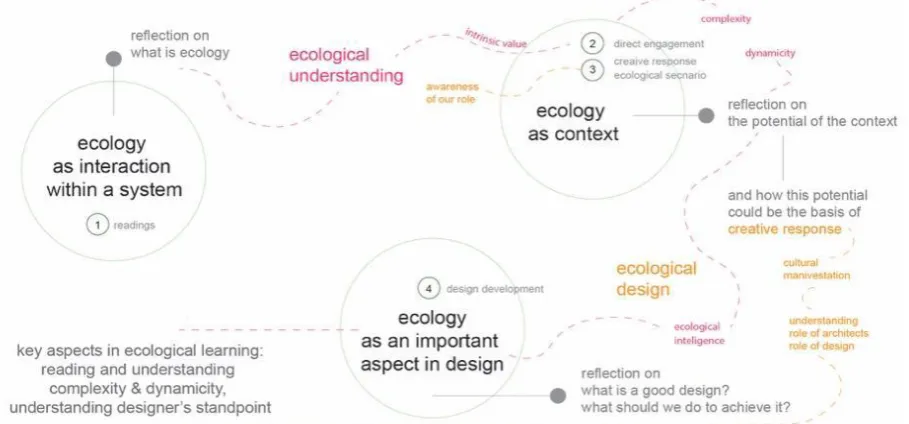REFLECTION ON ECOLOGICAL LEARNING THROUGH
ARCHITECTURAL DESIGN STUDIO
Diandra Pandu Saginatari1*, Paramita Atmodiwirjo2
1,2
Department of Architecture, Universitas Indonesia, Depok, INDONESIA *Corresponding author; Email: diandrapandu@ui.ac.id
ABSTRACT
Architecture, both in the practice and the education, is moving toward a higher environmental awareness. It is shown from the inclusion of ecology as one of the core subject in the curriculum. But, ecology is dominantly viewed and learned through a scientific and qualitative approach rather than a creative design methodology. This paper argues that ecology always has a potential to become the basis of creative design process. There are three key aspects in learning ecology in architecture: learning ecology as reading complexity, as understanding dynamicity, and as building up awareness of our position as designers. These key learning aspects are enabled by the nature of architectural design studio as educational environment. This paper examines the key aspects of ecological learning within one of the design studio in Universitas Indonesia. The study concludes that there is a relationship between the learning stages of the design project and the ecological understanding of the students.
Keywords: Ecological learning; creative response; architectural design studio.
INTRODUCTION
Architecture is a multifaceted discipline that is not limited to one body of knowledge. It comprises a diverse perspective that collides both creative and rational thinking. Architecture is currently moving towards a higher environmental awareness and envi-ronmental issues become important aspects not only in architectural practice but also in architectural edu-cation. Environmental issues emerge through the inclusion of „ecology‟ in architectural education. Terms such as performance ecology, ecological based concept, ecology and sustainability increasingly appear as themes and core subjects in architectural design studio (Goodbun, 2012). But in general ecology tend to be directly related to sustainability (Catalá, 2010) that implies a rather technical and qualitative point of view. It tends to generate design concepts such as „green architecture‟ or „zero energy building‟ that is usually produced in the later years in architectural education because of the advanced technicality required. It implies that this type of ecological learning will develop applied knowledge of technological implementation to solve environmental issues. This paper argues that there is more to ecology rather than a technical and qualitative body of knowledge in architectural education, and that the awareness of ecology needs to be nurtured from early stage of education.
Ecology is a term in biology that deals with the science of the relationship between the organism and
its environment, and the practice of ecology evolves around the construction of model from the interaction between organism and the environment (Sarkar, 2005). Ecology also refers to “the interdependent (enduring or temporary) relationship between the physical and biological components of an environ-ment that function as one whole ecological unit” (Catalá, 2010, pp.89). Based on those statements we can argue that learning ecology is essentially learning about reading relationship, interrelationship, connec-tivity, networks within a complex system. Learning ecology seems to have the potential to build up under-standing which is not merely based on quantitative aspects, such as efficiency, productivity, and technical skill, but based on the understanding of interrelated structure under a set of rules (Orr, 2002).
LEARNING ECOLOGY THROUGH ARCHITECTURAL DESIGN STUDIO
To enact ecology as the basis of architectural education, one should be able to recognize key aspects in ecological learning. There are at least three key aspects in learning ecology. First, learning eco-logy means learning to read interaction in complexity. "Ecological systems are complex assemblages of interacting organisms embedded in an abiotic envi-ronment" (Hartvigsen, Kinzig & Paterson, 1998, pp.427). Based on Hartvigsen et al. (1998), ecological systems are the assemblages of interactions, and by learning this, one could build an understanding towards how various parts and elements relate, inte-ract, and connect to construct a system. The under-standing could also extend towards an awareness of the hierarchical order within the system that unfolds the role of each parts within the system.
Second, learning ecology is about reading
dyna-micity within a context. “Yet ecology is a rapidly
evolving field that has undergone major paradigm shifts in the past two decades. It no longer presup-poses a „balance of nature‟, but instead describes the natural world in terms of flux and change” (Johnson & Hill, 2002, pp.1). Learning ecology is not about trying to achieve “balance of nature”, which implies to a rather problem solving manner. Learning ecology is about reading “flux and change”, which implies that an ecological system is a dynamic system. The dynamicity of ecological system opens to various responses rather than particular problem solving. This understanding of dynamicity could derive creative responses in learning ecology in architecture.
Third, the other dimensions that are worth recog-nizing in ecology are the process, integration, and humanity. “…ecology is understood as an intellectual and professional endeavor that includes physical, biological, and cultural dimension, and occurs across multiple spatial and temporal scaled in contexts
ranging from urban to pristine” (Ahern et al., 2002,
pp.397-398). Eventually, learning ecology is not only about understanding the complexity and dynamicity of a system but to finally put ourselves, a designer, within the system. Creative responses that emerges when learning ecology in architecture should be a learning ecology could be embedded within studio learning. The aim of learning ecology in the design studio is to achieve an ecological understanding.
Based on Hill (2002), ecological understanding is actually how to understand the intrinsic value of something. This signifies that ecological understand-ing requires a deep and critical understandunderstand-ing on how the internal parts and elements of a system really work. Besides, ecological understanding is also about understanding the awareness of how human action could affect and intricate the whole relationship, interrelationship, connectivity, and network of pat-terns and processes in the environments (Hill et al., 2002).
This ecological understanding could then be the basis of the design process in the design studio that is aimed at creating an “ecological design”. Based on Nassauer (2002), ecology and design are two different ways in looking at things, the nature of ecology is scientific while the nature of design is a creative and cultural action. This indicates that ecological design is actually a creative response with a scientific basis. “A design process provides a framework to focus creativity on the goals of the project, inspired and tempered by knowledge of the site and its context. It provides methods to analyze sites, kindle imagination, rethink goals…” (Johnson et al., 2002, pp.306). This statement shows that the knowledge of the site and its context as one form of ecological understanding could be an important insight in developing creativity in the design process through a critical and analytical way. The design process that comprises an ecological understanding as well as creative, critical, and analytical process, could lead to a “good design” which requires an ecological intelligence (Karr, 2002). Ecological intelligence refers to how one has a deep understanding towards how nature really works. This deep understanding will lead to a place specific ecological design (Karr, 2002).
Fig. 1. Key aspects of ecological learning in design studio
generate ecological design where the key aspects of learning ecology are embedded. Figure 1 shows how these three keys are embodied in the process of designing based on ecological understanding in design studio. The nature of architectural design studio that focuses on self exploration through creativity, critical, and analytical process could enable an ecological learning. Universitas Indonesia. In particular, we will discuss the learning in Architectural Design 1 Studio (AD1 Studio) for third semester students. The general learning objective of this studio is to design a spatial structure based on the understanding of relationship between self and the surrounding spaces. This studio is considered important and critical because it is the first opportunity for the student to encounter with an architectural design project. It encompasses the under-standing of basic architectural knowledge such as understanding personal spatial experience, interaction between human body and space, and understanding the surrounding context (Academic Guidebook Architecture Department, 2017). This paper will reflect on the recent AD 1 Studio project with the main theme “Design with Nature”. This studio specifically addressed the idea of ecology as the basis of creative spatial response in designing space for inhabitation. This studio had four major stages which are: readings, direct engagement with the context, creative response in the form of ecological scenario, and design development.
In this studio, nature became the key element of the process. Nature was introduced through several readings at the beginning of the studio. These readings gave basic understandings about ecology, landscape and the design process. This studio used the understanding of natural context as a system as the basis of the whole design process. The approach is based on the view of studio project as system (Wang, 2010), and thus, exploration in creativity and rationality to unfold relational aspect is possible. The aim of the studio is to generate various responses toward issues rather than to find solution for specific problem. To have this understanding, the students were required to conduct the direct engagement to the context. The students were expected to have an ecological understanding by unfolding the dynamic
relation, interrelation, connectivity, networks, and hierarchy within the context. This learning by doing process of direct engagement with the site is one of the advantage of design studio as learning environ-ment. In this process the students explored the context creatively through experimentation and analysis to understand the context as an ecological system intimately and thoroughly.
At the end of the project, the students were
expected to create an „ecological design‟ that
demonstrates their creative response to the existing ecology in the natural context. The creative response should encompass the designer‟s stand in making the responses based on their understanding of the context and the user‟s bodily needs. The expected response was to „create with‟ nature rather than „added into‟ nature. Design studio is a complex process of material representation, social collaboration, and creativity (Wang, 2010). It was also reflected in this studio where the students had to demonstrate their creative response through creative representations.
Fig. 2. The stages of learning, from ecological under-standing to ecological design
Figure 2 shows the summary of how the studio stages lead to the key learnings of ecology. The first two stages were dedicated to build the ecological understanding to create ecological design. The com-bination of theoretical knowledge and the direct engagement built a solid ecological understanding. Then, ecological design was created through the later stages in the studio, through the making of ecological scenario and the design development. The stages reflected the key aspects of learning ecology, which consist of understanding complexity, understanding dynamicity, and understanding our stand as designer.
Method of analysis
The main purpose of this study is to examine how the students build up their understanding towards ecology in architecture through a design project, particularly through the studio project “Design with
Nature”. The study was conducted through the con
studio processes. Content analysis is a qualitative approach that is appropriate to understand a specific circumstance because it has a more personalized detail and complexity (Lucas, 2016). This demon-strates how the content analysis as qualitative appro-ach is suitable to study a personal and complex data.
The data was gathered at the end of the project where the students were asked to explain their understanding about ecology based on the design process throughout the project in 300-500 words of essay. Then, the statements within the essays were analyzed by referring to the three key aspects of ecological learning. The statements are categorized into three groups. The first category is the statements that reflect understanding complexity which shows the understanding about ecology as interaction and system. The second category is the statements that reflect understanding dynamicity which shows the understanding of the ever changing context. The third category is statements that reflect awareness of
designer‟s stand which shows creative response and
how architecture should be practiced in accordance to ecology. Through content analysis, this study attempted to discover how the stages of the design studio promote ecological learning that reflects the three key aspects of ecological learning.
REFLECTION ON LEARNING ECOLOGY THROUGH ARCHITECTURAL DESIGN
STUDIO
The essays of the students show different ways of how they built their understanding about ecology. Some students defined what ecology is, some include-ed the design process in explaining their understand-ing, and some attempted to make a statement about what we should do as architects in creating ecological design. Throughout the essays we could reflect back on the there key aspects in ecological learning, which include understanding complexity, understanding
dynamicity, and understanding the designer‟s stand
-point.
Understanding complexity: Ecology as an interac-tion within a system
Learning about ecology through the design studio is achieved by integrating the learning stages and the studio content. Starting the encounter with reading becomes a way to build a basic understanding about ecology that becomes the basis of the design project. Reading theory is considered important as an introduction to the topic. “Choosing key articles or chapters that are the most pertinent to the studio
project helps students from becoming overwhelmed
with the science.” (Poole et al., 2002, pp.442). Read
-ing could give an overview about the „science‟ that could derive the basic understanding of the topic, which in this studio is ecology.
“The reading stated that ecology is a vital inte
-raction between organism and its environment. This understanding became my basis to start the
project.” –AR
“From the reading, I understood ecology as
relationship between human and other living
thing with its surrounding environment.” –MHH
“I learned from [the reading] that ecology is
interaction between organisms and environment
they occupy.” –ANR
Some of the students remarked on how they could build up their understanding towards ecology from the readings that are given in the beginning of the project. As an example, AR stated that he/she got introduced to the topic of ecology from the reading and started the design project with this understanding. MHH and ANR made statements that shows their understanding of the definition of ecology based on the reading. These statements reflected a basic under-standing of ecology as an important interaction among the organism (living things) and the environ-ment that they occupy. Such understanding could be found in most of the students‟ essays.
The statements below showed examples of how ecology was being understood as a form of interac-tion, as expressed by the terms „interaction‟ and „relationship‟. Some of the statements showed how this understanding of ecology as interaction was extended to further understanding. For example, AT stated that the interaction in ecology happened because of how human utilized the potential of the environment, while MK stated that ecology as interac-tion was an important aspect in architecture because architecture would always include interaction bet-ween the environment and the human.
“I think ecology is an interaction between
human and the environment. The interaction is enabled because of the potential of the
environ-ment for human inhabitation.” –AT
“Ecology, for me, is a relationship between
environment and the living things because everything in nature is interact with each other. Ecology is an important aspect in architecture because architecture contains interaction
bet-ween human and the environment.” –MK
„The focus of ecology is how natural element
interact or relate with the surrounding environ-ment, and how the environment response the
“Ecology is an analysis of relation and interac -tion between living things and the surrounding environment. It means that ecology is actually
happened where ever we are.” –EHT
Beside being understood as interaction, ecology was also understood as a system, as indicated by the following statements.
“I think ecology is a system in nature. I think the phrase of „landscape as system‟ could sum up
the meaning of ecology. Ecology is a natural system in which lies reciprocal relationship between nature and living things such as
human.” –AYP
“For me, ecology is a reciprocal system between
human and the environment.” –TRR
“I think ecology is a system that include how
living organism and the environment interact
and in response with each other.” –ZR
Some students mentioned the understanding of ecology as a system that comprised interaction and reciprocal relationship between the living things and the environment. Some of the students reflected on ecology as an even broader system. Some of them tried to formulate ecology as the life itself, as in the following statements.
After each of the students revealed the potential of the site, the students were expected to do a higher reasoning (Auer, 2008). In this studio, it was done by proposing an ecological scenario as a creative res-ponse. The students had to design a living scenario for an individual to be among nature during 3-4 days. Ecological scenario refers to an activity scenario that
is developed based on the ecological understanding from the previous stages.
“The ecological scenario also one of the impor
-tant thing that need to be consider while design a space. The space needs to accommodate the
activity based on the analysis of the site.” –SAA
“Formulating the ecological scenario is when I
analyze the interaction about what will my client going to do their activities on the site and the
environment on the site.” –AK
“From the analysis, I created an ecological scenario for the client‟s activities in nature. The
ecological scenario showed which activity re-quires direct or indirect interaction with
na-ture.” –HAK
The students highlighted the importance of ecological scenario in the design process and how this ecological scenario is based on the understanding from the engagement and exploration of the context as in the following statements. The following state-ments showed the examples of how students generated their ecological scenario. AF tried to see how the roots of the trees could have the potential to help someone climbing the contoured land. BW tried to see how tendril of trees could be an exercise equipment. CD saw the potential of a contour and its texture to be a comfortable sitting space. The statements indicated a hint of how ecological scenario comprises the understanding of the context and the human body.
“For example, roots that come out the ground
on an angled surface could be function as a
handle to climb the contour.” –AF
“After the exploration, I found potential ele -ments from the site that could be my design elements. For example, an arched tree and its
tendrils could be use for exercise element.” –BW
“As an example, a contour with the texture from
the grass could be used as a seat.” –CD
More statements below showed how the stu-dents included ergonomic aspect in generating this ecological scenario. This ecological scenario became the basis of spatial programming that include the zoning of the activity and everything was based on the contextual understanding and the ergonomic aspect of human body.
“My ecological scenario is connecting all client
basic need and relaxing need with vista nature
can offer…. First I create border, divide space
based on function for client. Contrast vista for painting, focus vista for searching an inspi-ration, wide serene vista for contemplating plus doing other activities (such as eating, praying), enclose vista for bathing, segmented vista for walking, and a present of vista on top for
sleeping.” –ANR
I put the the space that needs privacy such as bathroom and toilet in the cool color zone while I put bed room, reading space, and panted space in the warm color zone so these spaces will have
enough sunlight.” –MK
“I try to combine ecological aspects of stem
characteristic as visual element and using the direction of the wind to make smell circulation
within the space….” –SF
The translation from contextual understanding to a creative response in the form of ecological scenario is also illustrated in the visual representation that the students produced in this stage as in Figure 4. The outputs include an ecological scenario that are presented as a creative activity schedule and also the allocation of human activity within the site.
The statements above illustrate how each student engage with the site creatively in different ways. Each of the students built their deep and personal under-standing about the ever changing context and translated that to an ecological scenario as a creative response. This suggests that the students engaged with the dynamicity of the context and this dynamicity become the rich sources for creative response in the students‟ design process.
Understanding designer’s standpoint: Ecology as
important aspect in design
All of the understanding about ecology, and how it becomes the basis of generating a creative response, should lead to how the students design their architec-ture ecologically. The students‟ reflection essays also
demonstrated their attitude toward design. The statements below reflected the students‟ awareness of the role of architect or designer in determining the value of our design in the environment.
“In conclusion, it means ecology is needed and
related to the design process and it should
become the philosophy of a space.” –SAA
“So, as a designer, ecology is a crucial aspect
that needs to be understood deeply through ana-lyzing various aspects in nature, and the design should survive and unite with the changes in the environment such as temperature, sunlight, rain,
etc.” –SF
Statements above show the students‟ reflection upon the role of ecology in design process. AIP 5 stated that ecology is essential in the design process and ecology should be the philosophy of space. SF also reflected on how ecology becomes a crucial aspect that could derives our design to survive and unite with the ever changing nature of the natural context. Natural context becomes an important element in design process because, as stated by VT and GCV below, designing with ecology means to focus on the sensibility towards the context that could unfold the potential of the context as the basis for the design itself. ASL highlighted that ecology is closely related with design process where we architect have to understand the context where we will design our architecture so that we could design the interaction between the design, the human, and the environment.
“Designing using ecological scenario means
that our focus of designing is to emphasize the aesthetic beauty of the interaction among
orga-nisms and their surrounding habitats.” –VT
“Designing ecologically means to use sensitivity
towards a context. We had to dig the potential of the context then design based on that, not from
scratch.” –GCV
“The definition of ecology has something to do
with architectural design, because in designing, architect has to understand the context where the design will be, the potential that the context has, and what kind of interaction possible based
on the context.” –ASL
Some students reflected on how their design works and they reflected on the role of their design among the environment.
“My design is the response based on my
under-standing toward the context and the client.” –
MHH
“As a frame, or semi permeable membrane
between the client and nature, my architecture
has a role of selecting what fragments of nature she experiences. The role of selecting involves inclusion and exclusion... In conclusion, the ecology of my design creates a more focused and saturated visual experience for my client. It interacts with nature by selecting from it and giving the client a more structured visual
experience.” –CNM
MHH stated that his/her design is a response from contextual understanding and also client‟s vision. CNM clearly stated how his/her architecture acts as a semi permeable membrane with the role of selecting vistas for different activity. These show how the design was derived from the contextual under-standing that tries to create interaction between the environment and the human. The design became a particular response toward certain potential of context. And this influenced how the students produced their architectural drawings. Figure 5 shows several exam-ples of how the students tried to communicate how the design is intertwined with the context and the activity within.
“Ecology is like a chain where we live in inte
-raction with another, survive, and the inte-raction is expanding. Based on my understanding, I
could conclude that ecology is the life itself.” –
HK
“Last but not least, ecology is human + nature + activity + spatial needs = the pattern of life.” –VS
The examples of the students‟ statements above
suggest how the students understood ecology as a complex interaction and as a system through readings and the whole process of design. The students understood that within ecology there are elements and parts that interact, relate or respond to each other to construct a system. Therefore, the statements suggest that the students‟ awareness of the complexity of ecology.
Understanding dynamicity: Ecology as context
that direct engagement to the physical environment would provide the students with a rich source of inspiration and precedent that could be a key starting point of the design process. He also stated that this direct engagement, in a form of site visit and site analysis, should and could enhance the students‟ ability in using their senses to perceive the
surro-unding (Watson, 2014). Students‟ ability in percei
-ving the surrounding depends on how sensible they are in using their senses to perceive the environment because senses in human body is considered an important instrument for comprehending the surro-unding environment (Yatmo & Atmodiwirjo, 2013). But, in order to be able to „exploit‟ the real potential of the context, the students have to include their analytical skill to this sensibility (Watson, 2014). Understanding about ecology as the study of interre-lated system itself has the potential to be an analytical tool to unfold complex system and issues (Saginatari & Atmodiwirjo, 2018). Therefore, in this learning stage the students were expected to use both their sensory and their analytical skills to build their ecolo-gical understanding in the natural site context.
Statements below showed that, after having a basic understanding of ecology, the students started their design by understanding the context through a creative engagement. AR and RR highlighted how this contextual exploration and analysis became the first step in the design process. In this contextual exploration and analysis they were required to use their senses to generate responses toward the existing context. The involvement of sensorial experience in the contextual engagement generated creative and personal ways of understanding the context. As an example, MK tried to categorize the context based on the colors caused by the sunlight and ended up with
an understanding that the natural context consists of warm and cool colors, while VS focused on the distance between trees that creates various visual framing.
“It began with site exploration. From the project
brief, we were expected to analyze everything on the site, such as sound, smell, and other things that become the influencing factor oh how
human lives in nature.” –AR
“Then, I analyzed the chosen site thoroughly
from the light, texture, sound, vegetation and so on, in refer to my sensory catalogue. Through the analysis, I could find the characters and the
uniqueness of the site.” –RR
“I categorized the site based on the colors from
the direction of the sunlight. After further analy-sis, I found that the site could be categorized as
warm colors and cool colors zone.” –MK
“I selected the ecological component of vege
-tation, which was the various distance between trees, that will frame different views. Then, I made an abstraction of the frame so I got
various shapes.” –VS
This contextual understanding is also reflected
on the students‟ visual representation of the contextual
engagement. Various modes of representation were used to demonstrate their analytical process and creative thinking. Some example of the output created by the students in this stage are illustrated in Figure 3.
Some students also expressed a broader under-standing about what is considered as a good or ecological design and how we should act with our design.
“I think a good design is a design that suite the
natural condition. Ecology is closely related
with our daily activity. Therefore, ecology is one of the factor to be considered when we design in
natural context.” –RRS
“My understanding of the objective of the design
is that user are not living despite being in nature but living along side an alive setting. Our design supposedly thinking about natural phenomenon such as rain, site climate, and water cycle and how user can be comfortable even the
pheno-menon can be against them.” –HS
“When human build a building, we have to
consider every related part. We have to see the
environment as part of the building…. Architec
-ture could create interaction between living
things, the design, and the environment.” –SMA
“Our design has to be in unity with the surro
-unding environment. We have to see what kind of relationship there, in the context, and our design should enhance the quality of that
rela-tionship.” –AYP
“Architecture should not remove the relation
-ship between living things and the
environ-ment.” –KFA
RRS reflected how a good design is the one that consider the environment and ecology to place the design in the context. HS stated that the design is not just being in nature but living along side the nature, and AYP also stated that the design should be one system with the environment. In order to have a good design that responsibly blends with nature, SMA and AYP stated the needs to pay attention to the kinds of interaction and relation that exist in the context. At the end, as SMA, AYP and KFA stated, our design and our architecture should be able to create, maintain,
and enhance any interaction and relation that exist in the context. The examples of statements above suggest clearly that the students were aware of their position, as designer, and the position of their design. This reflects the last key aspects in learning ecology which is about the understanding of our position within the ecological system.
Summary of findings in learning ecology through architectural design studio
The above findings describe the reflection from the students which demonstrate their understanding towards ecology. Figure 6 summarizes the process, which began with the reflection upon the definition of ecology as interaction within system, the exploration of finding the ecology within the context, and ended up with a reflection upon the understanding of the importance of ecology in design process. These understanding could be related with the design stages of the project. The understanding about ecology as interaction within a system is related to the intro-ductory reading of the project, which builds the basic understanding of ecology. The understanding about ecology as context is related to the contextual enga-gement and creative response stages of the project. The understanding of ecology as an important aspect in design is related to the design development stage of the project which also demonstrates the accumulation of understanding after the whole learning process.
The reflection of the students also suggests its relevance towards the ecological understanding and ecological design principles that lead to the achieve-ment of the key aspects of ecological learnings. The
understanding of ecology as interaction within a system implies the understanding of complexity in ecology. The understanding of ecology as context demonstrates the awareness of dynamicity within the context. And, the understanding of ecology as an important part of design remarks the awareness of the position as designer and the position of our design within the ecological system. This project has attempted to integrate the key aspects in learning ecology in architecture, it demonstrates how ecology is not only about problem solving but also about generating creative contextual responses.
CONCLUSION
This study attempted to address the ecological learning process in architectural education. In parti-cular, this paper argues that ecology could be the basis of creative process, as demonstrated through the learning process in the architectural design studio. Through the content analysis of the students‟ reflec -tion at the end of the learning process, the study found that learning ecology in architecture comprises the three key aspects, the understanding of complexity, the understanding of dynamicity, and the ability to put ourselves as designer within this complexity and dynamicity. By integrating the key aspects into design studio project, the learning process emphasizes the understanding of the system rather than merely the problem solving. The stages of the project have signi-ficant role in building up the students‟ understanding of ecology. Reading is a prominent part where the students build the foundation to start the project. Then, direct engagement with the context is also a key in the process of understanding. In this process the students directly engage with the context to under-stand its complexity and dynamicity, and also put themselves within the context. Based on this under-standing, the students are challenged to response creatively to the context through the development of ecological scenario, spatial programming, and the design development. By integrating the key aspects of ecological learning, the design studio becomes a potential learning environment to develop the stu-dents‟ ecological understanding and awareness. It is possible to promote ecological learning which is not just dealing with the scientific and measurable as-pects, but providing opportunities to generate creative responses to the context.
ACKNOWLEDGMENT
The students‟ works and reflection essays presented in this paper are gathered from the
Archi-tectural Design Studio 1 at Universitas Indonesia in 2017 under the supervision of Paramita Atmodiwirjo, Yulia Nurliani Lukito, Rini Suryantini, Rossa T. S. Simatupang, Siti Utamini, and Amira Paramitha.
REFERENCES
Ahern, J., et al. (2002). Integrating ecology “across” the curriculum of landscape architecture. Johnson, B. R., & Hill, K. (Eds.). Ecology and
design: Frameworks for learning (397-414).
Washington, DC: Island Press.
Auer, M. R. (2008). Sensory perception, rationalism and outdoor environmental education. Interna-tional Research in Geographical and
Environ-mental Education, 17(1), pp. 6–12.
Catalá, A. (2010). Numerical ecosystems.
Architec-tural Design, 80(6), pp.86-93.
Goodbun, J. (2012). Flexibility and ecological plan-ning: Gregory Bateson on Urbanism.
Architec-tural Design, 82(4), pp. 52-55.
Hartvigsen, G., Kinzig, A. & Peterson, G. (1998). Complex adaptive systems: Use and analysis of complex adaptive systems in ecosystem science: Overview of special section. Ecosystems, 1(5), pp. 427-430.
Johnson, B. R. & Hill, K. (Eds.). (2002). Ecology and
design: Frameworks for learning. Washington,
DC: Island Press.
Johnson, B.R., Silbernagel, J., Hostetler, M., Mills, A., Ndubisi, F., Fife, E. & Hunter, M. R. (2002). The nature of dialogue and the dialogue of nature: Designers and ecologist in collaboration. Johnson, B. R., & Hill, K. (Eds.). Ecology and
design: Frameworks for learning (305-356).
Washington, DC: Island Press.
Karr, J.R. (2002). What from ecology is relevant to design and planning?. Johnson, B. R. & Hill, K. (Eds.). Ecology and design: Frameworks for
learning (133-172). Washington, DC: Island
Press.
Nassauer, J.I. (2002). Ecological science and land-scape design: A necessary relationship in chang-ing. Johnson, B. R., & Hill, K. (Eds.). Ecology
and design: Frameworks for learning (217-230).
Washington, DC: Island Press.
Orr, D. W. (2002). The nature of design: ecology, cul-ture, and human intention. New York: Oxford University Press.
Saginatari, D. P. & Atmodiwirjo, P. (2018). Ecology: Creative Tool in Understanding Interrelated Sys-tem. SHS Web of Conferences, 41, 06002. Sarkar, S. (2016). Ecology. In E. N. Zalta (Ed.), The
2016). Metaphysics Research Lab, Stanford University. Retrieved from https://plato.stanford. edu/archives/win2016/entries/ecology/
Poole, K., Galatowitsch, S., Grese, R., Johnston, D., Keller., J. T., Richey, D. & Woodward, J. (2002). Building ecological understanding in design studio: A repertoire for a well-crafted learning experience. Johnson, B. R., & Hill, K. (Eds.). Ecology and design: Frameworks for
learning (415-472). Washington, DC: Island
Press.
Wang, T. (2010). A new paradigm for design studio education. International Journal of Art &
Design Education, 29(2), pp. 173–183.
Watson, R. (2014). Learning from the environment and making: Using analysis and the senses.
Journal for Education in the Built Environment,
9(1), pp. 69–88.
